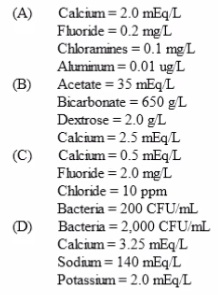A patient is admitted for routine dialysis and complains of diarrhea It is important to report this to the nurse. Which of the following treatment modifications may be needed?
A. Initiate sodium-modeling program
B. Modify dialysate potassium level
C. Apply ultrafiltration (UF) profile
D. Alter dialyzer selection
Which of the following a NOT important in maintaining accurate blood flow rates?
A. Periodic testing of calibration
B. Internal diameter of the blood pump segment
C. The length of tubing between pump and dialyzer
D. Checking the calibration when changing tubing manufacturers
In treated water meeting the Association for the Advancement of Medical Instrumentation (AAMI) standards, the maximum allowable CFU of bacterial contamination is
A. 100.
B. 200.
C. 1000.
D. 2000.
Which of the following statements regarding members of a quality assurance (QA) committee is correct?
A. All members of the healthcare team should be represented.
B. The medical director and the nurse only collect the data.
C. Social workers and nurses should only attend the meetings.
D. Patients should not be encouraged to attend.
Water that b safe for drinking is NOT necessarily safe for dialysis because
A. a patient's urine output is decreased.
B. fluid removal is a problem in renal patients.
C. a patient is exposed to a large amount of water during the dialysis treatment.
D. small amounts of products are removed during the filtration process.
The use of bicarbonate has changed the dialysis delivery to include
A. decreased need for monitoring blood pressure during dialysis.
B. increased need for sterilization of solution containers.
C. poorer clearances at low blood pump speeds.
D. decreased dialysis time for patients.
The anemia associated with renal failure is an ongoing complication for many patients with end stage renal disease (ESRD). Which of the following statements identifies a technician's MOST appropriate action for minimizing the anemia during dialysis?
A. Request a dietary consult
B. Give vitamin supplements during dialysis
C. Minimize blood loss through careful technique
D. Perform hemoglobin and hematocrit studies with each treatment
Toxic products that accumulate in the body as a result of decreased kidney function are urea
A. creatinine, bile, and salt.
B. creatinine, potassium, and phosphorus.
C. potassium, amylase, and water.
D. sodium, potassium, and alkali.
Which of the following are the Association for the Advancement of Medical Instrumentation (AAMI) recommended maximum levels for chemicals and organisms usually found in water used for dialysis patients?

A. Option A
B. Option B
C. Option C
D. Option D
If several patients developed pyrogenic reactions during the past week while on dialysis, the nurse should check the water for
A. yeasts.
B. fungi.
C. gram-positive bacteria.
D. gram-negative bacteria.
The patient's laboratory results are positive for Human Immunodeficiency Virus (HIV) antibodies. A correct statement regarding HlV-positive patients on dialysis is that they can be dialyzed
A. in a hospital-based or freestanding unit using dialysis precautions.
B. only in hospital-based dialysis units with isolation stations.
C. in hospital-based or freestanding units with isolation stations.
D. only in units with isolation stations using dialysis precautions.
All of the following are likely contributing factors to frequent clotting of dialyzers on a machine EXCEPT
A. access recirculation
B. high ultrafiltration (UF).
C. high dialysate flow rate.
D. inadequate heparinization
| Page 1 out of 9 Pages |